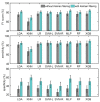Improved detection of Parkinsonian resting tremor with feature engineering and Kalman filtering
- PMID: 31744673
- PMCID: PMC6927801
- DOI: 10.1016/j.clinph.2019.09.021
Improved detection of Parkinsonian resting tremor with feature engineering and Kalman filtering
Abstract
Objective: Accurate and reliable detection of tremor onset in Parkinson's disease (PD) is critical to the success of adaptive deep brain stimulation (aDBS) therapy. Here, we investigated the potential use of feature engineering and machine learning methods for more accurate detection of rest tremor in PD.
Methods: We analyzed the local field potential (LFP) recordings from the subthalamic nucleus region in 12 patients with PD (16 recordings). To explore the optimal biomarkers and the best performing classifier, the performance of state-of-the-art machine learning (ML) algorithms and various features of the subthalamic LFPs were compared. We further used a Kalman filtering technique in feature domain to reduce the false positive rate.
Results: The Hjorth complexity showed a higher correlation with tremor, compared to other features in our study. In addition, by optimal selection of a maximum of five features with a sequential feature selection method and using the gradient boosted decision trees as the classifier, the system could achieve an average F1 score of up to 88.7% and a detection lead of 0.52 s. The use of Kalman filtering in feature space significantly improved the specificity by 17.0% (p = 0.002), thereby potentially reducing the unnecessary power dissipation of the conventional DBS system.
Conclusion: The use of relevant features combined with Kalman filtering and machine learning improves the accuracy of tremor detection during rest.
Significance: The proposed method offers a potential solution for efficient on-demand stimulation for PD tremor.
Keywords: Adaptive deep-brain stimulation; Kalman filtering; Local field potential (LFP); Machine learning (ML); Parkinson’s disease (PD); Tremor detection.
Copyright © 2019 International Federation of Clinical Neurophysiology. Published by Elsevier B.V. All rights reserved.
Conflict of interest statement
None.
Figures











Comment in
-
Advanced technologies for detecting tremor in Parkinson's disease.Clin Neurophysiol. 2020 Jan;131(1):241-242. doi: 10.1016/j.clinph.2019.11.006. Epub 2019 Nov 21. Clin Neurophysiol. 2020. PMID: 31806418 No abstract available.
References
-
- Arlotti M, Rosa M, Marceglia S, Barbieri S, Priori A. The adaptive deep brain stimulation challenge. Park Relat Disord. 2016a;28:12–7. - PubMed
-
- Arlotti M, Rossi L, Rosa M, Marceglia S, Priori A. An external portable device for adaptive deep brain stimulation (aDBS) clinical research in advanced Parkinson’s Disease. Med Eng Phys. 2016b;38:498–505. - PubMed
-
- Bakstein E, Burgess J, Warwick K, Ruiz V, Aziz T, Stein J. Parkinsonian tremor identification with multiple local field potential feature classification. J Neurosci Methods. 2012;209:320–30. - PubMed
Publication types
MeSH terms
Grants and funding
LinkOut - more resources
Full Text Sources
Other Literature Sources
Medical

